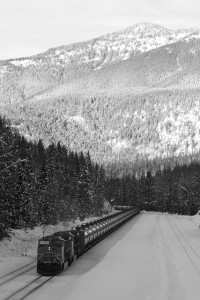
Custom Search
THE NORTHWEST'S PIPELINE ON RAILS
Sightline
March 6, 2014
Since 2012, nearly a dozen plans have emerged to ship crude oil by train to Northwest refineries and port terminals. Moving large quantities of oil by rail would be a major change for the Northwest’s energy economy, but so far the proposals have largely escaped notice.
Most media accounts to date have presented only a fragmented view of the developments, and government regulators are evaluating the projects largely in isolation from one another.
This memo presents the first comprehensive, region-wide review of all the oil-by-rail projects planned or currently operating in the Pacific Northwest. It finds that:
- In Oregon and Washington, 11 refineries and port terminals are planning, building, or already operating oil-by-rail shipments.
- If all of the projects were built and operated at full capacity, they would put more than 12 loaded mile-long trains per day on the Northwest’s railway system. Many worry about the risk of oil spills from thousands of loaded oil trains that may soon traverse the region each year.
- A string of high profile oil train explosions has raised widespread concern about the risks of moving crude oil by rail through populated areas. States and local governments across North America are beginning to seek more information about oil shipments and demand stricter tank car standards from federal regulators.
- Taken together, the oil-by-rail projects planned for the Northwest would be capable of delivering enough fuel to exceed the region’s oil refining capacity. Ironically, two of the facilities that would handle oil by rail were originally built to supply renewable fuels.
- The projects are designed to transport fuel from the Bakken oil formation in North Dakota, but the infrastructure could also be used to export Canadian tar sands oil. In fact, if all of the oil-by-rail projects were built, they would be capable of moving 858,800 barrels per day—that’s substantially more oil capacity than the planned Keystone XL pipeline.
- On Puget Sound, three of the region’s five refineries already receive oil-by-rail shipments, and the other two are planning new facilities. Three proposals for Grays Harbor would move oil along the Washington coast. And on the Columbia RIver, one port terminal is already receiving oil-by-rail shipments, while officials at Vancouver are planning by far the region’s largest facility and a nearby facility plans to transition to handling crude oil.
http://www.sightline.org/research/the-northwests-pipeline-on-rails/

